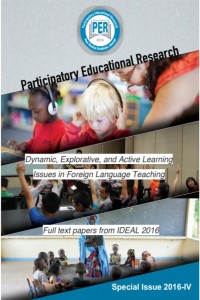Abstract
References
- Al-Qirim, N. (2011). Determinants of interactive white board success in teaching in higher education institutions. Computers & Education, 56(3), 827–838
- Barrett, S. (2014). Using Visuals to Help with Narrative Language, Retrieved on 15.11.2016 from http://missbarrettspeechlanguage.weebly.com/home/ using-visuals-to-help-with-narrative-language
- Çelen, F. K., Çelik, A. ve Seferoğlu, S. S. (2011). Türk Eğitim Sistemi ve PISA Sonuçları. XIII. Akademik Bilişim Konferansı, Malatya, Türkiye.
- Jones, L., C. (2002). Using Technology in Language Teaching and Listening Comprehension: Revisiting What Teachers Should Know and Do, IALLT Journal of Language Learning Technologies. 34 (2).
- Luk, H. (2014). Spoken English Leaning Video Spoken English Tutorial English Conversation, Retrieved on 15.11.2016 from https://www.youtube.com/ watch?v=IhQt_fxGOcw
- Manny-Ikan, E., Tikochinski, T. B., Zorman, R., & Dagan, O. (2011). Using the interactive white board in teaching and learning- an evaluation of the SMART classroom pilot project. Interdisciplinary Journal of E-Learning & Learning Objects, 7, 249-273.
- Mathews-Aydinli, M. J and Elaziz, F. (2010). Turkish students' and teachers' attitudes toward the use of Interactive whiteboards in EFL classrooms. Computer Assisted Language Learning, 23(3), 235-252
- Pamuk, S., Ergun, M., Çakır, R., Yılmaz, H. B., Ayas, C. (2013). The Use of Tablet PC and Interactive Board from the Perspectives of Teachers and Students: Evaluation of the FATİH Project, Educational Sciences: Theory & Practice, 13(3), 1815-1822.
- Sabzian, F. & Gilakjani A. P. (2013). Teachers' attitudes about computer technology training, professional development, integration, experience, anxiety, and literacy in English language teaching and learning. International Journal of Applied Science and Technology, 3(1) : 67-75.
- Sendurur, P. (2012). Identification of Factors Affecting Integration of Information and Communication Technologies in Basic Education Schools Grades From 4 Though 8 (Unpublished doctoral dissertation). Middle East Technical University, Ankara.
- Somyürek, S., Atasoy, B., Özdemir, S., (2009) Board’s IQ: What makes a board smart? Computers and Education, 53 (2) (2009), pp. 368–374
Abstract
In this study, researcher tried to understand
Foreign Language Teaching (English Language Teaching – ELT, and German Language
Teaching – GLT) students’ and teachers’ attitudes on interactive whiteboard
(IWB) that they would use in foreign language teaching. A descriptive study was
selected by using survey method. In this respect, data were gathered from 210
ELT and GLT students and 8 teachers from these two language teaching
departments in Erciyes University. Two questionnaires prepared by Manny-Ikan,
Tikochinski, Zorman and Dagan (2011) were administered to understand attitudes
of students and teachers: Teacher Attitudes Questionnaire (TAQ) and Students
Attitudes Questionnaire (SAQ). According to results; students mostly see
learning via the IWB is enjoyable, easier, understandable, favourable, and
interesting. Moreover, teachers mostly expressed that instruction with IWB is
more enjoyable, brings more workload, allows better access to up-to-date
learning materials, and contributes teachers’ professional development.
References
- Al-Qirim, N. (2011). Determinants of interactive white board success in teaching in higher education institutions. Computers & Education, 56(3), 827–838
- Barrett, S. (2014). Using Visuals to Help with Narrative Language, Retrieved on 15.11.2016 from http://missbarrettspeechlanguage.weebly.com/home/ using-visuals-to-help-with-narrative-language
- Çelen, F. K., Çelik, A. ve Seferoğlu, S. S. (2011). Türk Eğitim Sistemi ve PISA Sonuçları. XIII. Akademik Bilişim Konferansı, Malatya, Türkiye.
- Jones, L., C. (2002). Using Technology in Language Teaching and Listening Comprehension: Revisiting What Teachers Should Know and Do, IALLT Journal of Language Learning Technologies. 34 (2).
- Luk, H. (2014). Spoken English Leaning Video Spoken English Tutorial English Conversation, Retrieved on 15.11.2016 from https://www.youtube.com/ watch?v=IhQt_fxGOcw
- Manny-Ikan, E., Tikochinski, T. B., Zorman, R., & Dagan, O. (2011). Using the interactive white board in teaching and learning- an evaluation of the SMART classroom pilot project. Interdisciplinary Journal of E-Learning & Learning Objects, 7, 249-273.
- Mathews-Aydinli, M. J and Elaziz, F. (2010). Turkish students' and teachers' attitudes toward the use of Interactive whiteboards in EFL classrooms. Computer Assisted Language Learning, 23(3), 235-252
- Pamuk, S., Ergun, M., Çakır, R., Yılmaz, H. B., Ayas, C. (2013). The Use of Tablet PC and Interactive Board from the Perspectives of Teachers and Students: Evaluation of the FATİH Project, Educational Sciences: Theory & Practice, 13(3), 1815-1822.
- Sabzian, F. & Gilakjani A. P. (2013). Teachers' attitudes about computer technology training, professional development, integration, experience, anxiety, and literacy in English language teaching and learning. International Journal of Applied Science and Technology, 3(1) : 67-75.
- Sendurur, P. (2012). Identification of Factors Affecting Integration of Information and Communication Technologies in Basic Education Schools Grades From 4 Though 8 (Unpublished doctoral dissertation). Middle East Technical University, Ankara.
- Somyürek, S., Atasoy, B., Özdemir, S., (2009) Board’s IQ: What makes a board smart? Computers and Education, 53 (2) (2009), pp. 368–374
Details
| Primary Language | English |
|---|---|
| Subjects | Studies on Education |
| Journal Section | Research Articles |
| Authors | |
| Publication Date | December 1, 2017 |
| Acceptance Date | November 30, 2016 |
| Published in Issue | Year 2017 Volume: 4 Issue: 2 |



